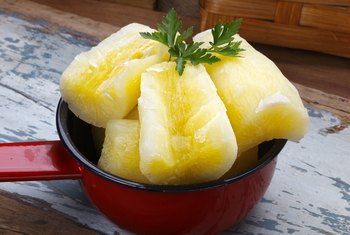Nutrition in Fufu Ghana

Fufu is an African staple that's commonly served in Ghana, but is popular in many other African countries, too. It's made by boiling yams, plantains or cassava and then pounding them into a dough-like ball. Diners pinch off small pieces of the food and dip it in soup and stew before eating it. Because it's made from boiled yams, plantains or cassava, it's a nutritious food that's low in fat and calories and that also supplies essential vitamins and minerals.
Fiber
Yams, plantains and cassava are good sources dietary fiber, a nutrient that keeps your digestive system working normally so your body absorbs nutrients from food. Getting plenty of fiber also reduces your risk of constipation and might lower your chances of developing certain health problem such as heart disease. A 1/2-cup serving of cooked yams supplies 2.7 grams of fiber, which is 11 percent of the 25 grams of fiber women need each day and 7 percent of the 38 grams men require on a daily basis. One-half cup of cooked plantains provides 2.3 grams of fiber, and 1/2 cup of cassava supplies about 1.9 grams of fiber.
Minerals
One of the key minerals in yams, plantains and cassava is potassium. Potassium helps regulate your heartbeat and promotes normal muscle function. One-half cup of cooked yams delivers 456 milligrams of potassium, and the same amount of cooked plantains supplies 465 milligrams. That's almost 10 percent of the 4,700 milligrams of potassium healthy adults need each day. One-half cup of cassava supplies 279 milligrams of potassium. Yams, plantains and cassava also supply small amounts of iron for healthy red blood cell production and zinc, which promotes wound healing.
Vitamins
A 1/2-cup serving of cassava provides 21.1 milligrams of vitamin C, which is 28 percent of the 75 milligrams women need each day and 23 percent of the 90 milligrams men should have on a daily basis. Vitamin C is an antioxidant that helps protect your cells from damage and it helps keep your immune system working well, too. The same portion of cooked plantains supplies about 11 milligrams of vitamin C. Yams supply about 8.3 milligrams of vitamin C per 1/2-cup serving. Yams, plantains and cassava contain small amounts of vitamin A for healthy eyesight, vitamin K for normal blood clotting and folate, which can help prevent birth defects.
Tips and Considerations
You can make your own fufu at home, though it takes a bit of time and strong muscles. Boil the yams, plantains or cassava until they're soft, mash the boiled vegetables with a potato masher and then beat them until they are completely smooth and thickened. The finished product is then rolled into a ball, according to Joseph R. Oppong and Esther D. Oppong, authors of "Ghana." Many recipes for fufu call for butter, which adds about 11.5 grams of fat per tablespoon. Other recipes call for added salt, and each teaspoon adds 2,325 milligrams of sodium to the fufu.
About the Author

Sara Ipatenco has taught writing, health and nutrition. She started writing in 2007 and has been published in Teaching Tolerance magazine. Ipatenco holds a bachelor's degree and a master's degree in education, both from the University of Denver.
HEALTHY EGGPLANT FUFU ( KONKONTE) KETO DIET
PEPPER SOUP
HOW TO MAKE PEANUT SOUP
GHANAIAN SPICES YOU PROBABLY MIGHT HAVE HEARD OF
Comments
Post a Comment